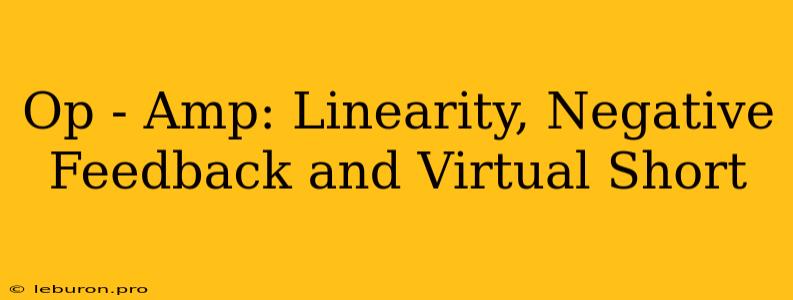The operational amplifier, often abbreviated as op-amp, is a fundamental building block in analog electronics. It is a high-gain, direct-coupled amplifier, typically implemented with a differential input and a single-ended output. While capable of amplifying signals, the true power of the op-amp lies in its ability to perform a wide range of analog circuit functions, thanks to its remarkable characteristics like linearity, negative feedback, and the concept of a virtual short. This article will delve into these core principles, explaining how they enable op-amps to become versatile tools for signal processing and manipulation.
Linearity
Linearity is a crucial characteristic of an op-amp that ensures accurate amplification without introducing distortion. In a linear amplifier, the output signal is a faithful scaled version of the input signal, maintaining the same waveform shape but amplified in magnitude. This linear relationship is essential for preserving signal fidelity and enabling accurate analog computations.
Op-amps are designed with internal circuitry that ensures a high degree of linearity over a specified input voltage range. This means that the output voltage will vary proportionally to the input voltage, within the operating limits of the device. However, it's important to note that op-amps have limitations. Beyond their linear operating range, the output may exhibit distortion, clipping, or saturation, compromising the integrity of the signal.
Negative Feedback
Negative feedback is a core principle that revolutionizes the performance of op-amps. It involves feeding a portion of the output signal back to the input, with a phase inversion. This feedback loop has a profound impact on the op-amp's behavior, significantly improving its linearity, stability, and precision.
Negative feedback helps to stabilize the op-amp's gain, making it less sensitive to variations in internal parameters or external disturbances. By reducing the open-loop gain, negative feedback effectively creates a closed-loop gain determined by the external feedback network. This predictable gain allows for precise amplification and manipulation of signals.
How Negative Feedback Works
Consider an op-amp configured with a feedback resistor. When the input voltage increases, the op-amp amplifies this change, producing a corresponding increase in the output voltage. This output voltage is then fed back to the input through the feedback resistor, opposing the initial change in input voltage. This opposing action effectively reduces the op-amp's overall gain, leading to a stable and predictable amplification.
Virtual Short
The concept of a virtual short arises from the combination of negative feedback and the op-amp's high open-loop gain. In practical implementations, the op-amp is usually configured with negative feedback to stabilize its gain and create a closed-loop system. This feedback loop effectively forces the op-amp's differential input voltage to be extremely close to zero, essentially creating a virtual short between the non-inverting (+) and inverting (-) inputs.
Impact of the Virtual Short
The virtual short has significant implications for circuit design and analysis. It simplifies analysis, allowing us to treat the op-amp's inputs as having the same potential, despite the fact that there is a small but finite voltage difference between them. This simplifies the calculation of currents and voltages in op-amp circuits, as we can apply the principles of Kirchhoff's laws and voltage dividers directly to the virtual short node.
Applications of Op-Amps
The remarkable properties of op-amps, particularly their linearity, negative feedback, and virtual short capabilities, have made them indispensable components in countless applications across various fields. Some of the most common applications include:
- Amplifiers: Op-amps are the cornerstone of audio amplifiers, instrumentation amplifiers, and signal conditioning circuits. They provide high gain, low distortion, and wide bandwidth, allowing them to accurately amplify and shape electrical signals.
- Filters: Op-amps can be used to construct a wide range of active filters, such as low-pass, high-pass, band-pass, and notch filters. These filters are essential for signal conditioning, noise reduction, and frequency-selective applications.
- Comparators: By utilizing the high gain of an op-amp, we can create circuits that compare two input voltages and produce a digital output based on the comparison result. These comparators are widely used in threshold detection, voltage level sensing, and analog-to-digital conversion.
- Oscillators: Combining op-amps with feedback networks, we can create electronic oscillators that generate periodic waveforms, such as sine waves, square waves, or triangular waves. These oscillators are used in clock circuits, signal generation, and timing applications.
- Active Load: In some applications, op-amps can act as active loads, providing a constant current sink or source. This can be useful in circuits where a stable and predictable load is required, such as in current-mode amplifiers and current mirrors.
Conclusion
The op-amp, with its inherent linearity, negative feedback, and the concept of a virtual short, has become a fundamental building block in analog electronics. Its remarkable properties enable it to perform a diverse range of signal processing and manipulation tasks, making it a versatile tool for a wide array of applications. By understanding the interplay of these key characteristics, engineers can effectively design and analyze circuits that exploit the full potential of the op-amp, contributing to the development of sophisticated and innovative electronic systems.
